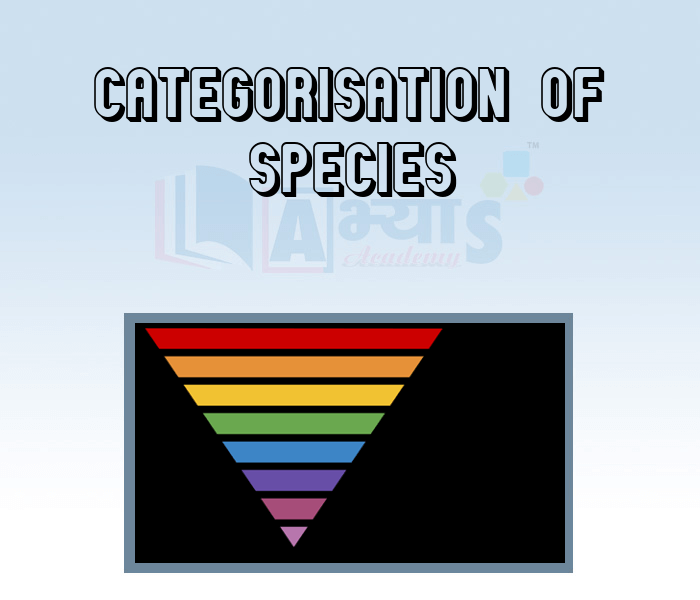Categorisation of Species










Categorisation of Species
CATEGORISATION OF SPECIES: The International Union for Conservation cf Nature and Natural Resources (IUCN) has categorised plants and animals species in order of existence. These categories are defined as follows:-
(i) Normal species Species whose population levels are considered to be normal for their survival such as cattle, sal, pine, rodents etc.
(ii) Endangered species Species facing a high risk of becoming extinct because they are few in numbers or threatened by changing environment or by predators. For example, black buck, crocodile, Indian wild ass, Indian rhino, lion tailed macaque, sangai (brow anter deer in Manipur), etc.
(iii) Vulnerable species Species whose population is decreasing and are facing a risk of moving into the endangered category. e.g, blue sheep, Asiatic elephant, Gangetic dolphin etc.
(iv) Rare species Species with a small population are rare. These can become vulnerable or endangered if the negative factors affecting them continue to operate. e.g., Himalayan brown bear, wild Asiatic buffalo, desert fox and hornbill etc.
(v) Endemic species Species which are only found in some particular areas due to their natural or geographical barriers. e.g., mithun (a variety of catrie, found only in Arunachal Pradesh), Andaman wild pig, Nicobar pigeon, Andaman teal etc. Arunachal Pradesh),
(vi) Extinct species Species which are not found after searches of known or likely areas where they may Occur. The extinct species category consists of those species which are also not available in captivity. e.g., Asiatic cheetah, pink head duck.
Increase in Forests Due to Plantation: The dimensions of deforestation in India are not fixed .The forest and tree cover in the country is estimated at 78.92 million hectare, which is 24.01 per cent of the total geographical area (dense fores: 12.24 per cent, open forest 8.99 per cent and mangrove 0.14 per cent). According to the State of Forest Report (2013), the dense forest cover has increased by about 10,098 sq km, since 1997, but this may be due to rise in plantations. This report does not differentiate between natural forests and plantations Therefore. these reports fail to deliver the exact situation.
Asiatic Cheetah : Where did they go? The cheetah (Acinonyx jubantus) is world's Bases land mammal. It is a unique and specialised member of cat family . It can run at the speed of 112 km/h. it is after mistaken for a leopard. Its distinguished marks are the long teardrop shaped lines on each side of the nose from the comer of its eyes to its mouth. Prior to the 20th century, cheetahs were widely distributed throughout Africa and Asia. Today, the Asiatic cheetah is nearly extinct due to a decline of available habitat and prey. In 1952, the species was declared extinct in India.
Which of the following are correct : (a) Blue sheep, Asiatic elephant, Gangetic dolphin etc.are examples of vulnerable species in India. (b) Black buck, crocodile, Indian wild ass, Indian rhino, lion tailed macaque, sangai (brow anter deer in Manipur), etc are examples of endangered species in India. | |||
| Right Option : C | |||
| View Explanation | |||
Species whose population levels are considered to be normal for their survival are known as ___________. | |||
| Right Option : C | |||
| View Explanation | |||
Species which are only found in some particular areas due to their natural or geographical barriers are known as __________________. | |||
| Right Option : B | |||
| View Explanation | |||
Students / Parents Reviews [10]
It has a great methodology. Students here can get analysis to their test quickly.We can learn easily through PPTs and the testing methods are good. We know that where we have to practice

Barkha Arora
10thIt was a good experience with Abhyas Academy. I even faced problems in starting but slowly and steadily overcomed. Especially reasoning classes helped me a lot.

Cheshta
10thAbhyas is a complete education Institute. Here extreme care is taken by teacher with the help of regular exam. Extra classes also conducted by the institute, if the student is weak.

Om Umang
10thMy experience with Abhyas is very good. I have learnt many things here like vedic maths and reasoning also. Teachers here first take our doubts and then there are assignments to verify our weak points.

Shivam Rana
7thA marvelous experience with Abhyas. I am glad to share that my ward has achieved more than enough at the Ambala ABHYAS centre. Years have passed on and more and more he has gained. May the centre flourish and develop day by day by the grace of God.

Archit Segal
7thIt was good as the experience because as we had come here we had been improved in a such envirnment created here.Extra is taught which is beneficial for future.

Eshan Arora
8thI have spent a wonderful time in Abhyas academy. It has made my reasoning more apt, English more stronger and Maths an interesting subject for me. It has given me a habbit of self studying

Yatharthi Sharma
10thMy experience was very good with Abhyas academy. I am studying here from 6th class and I am satisfied by its results in my life. I improved a lot here ahead of school syllabus.

Ayan Ghosh
8thMy experience with Abhyas academy is very good. I did not think that my every subject coming here will be so strong. The main thing is that the online tests had made me learn here more things.

Hiya Gupta
8thAbhyas Methodology is very good. It is based on according to student and each child manages accordingly to its properly. Methodology has improved the abilities of students to shine them in future.
